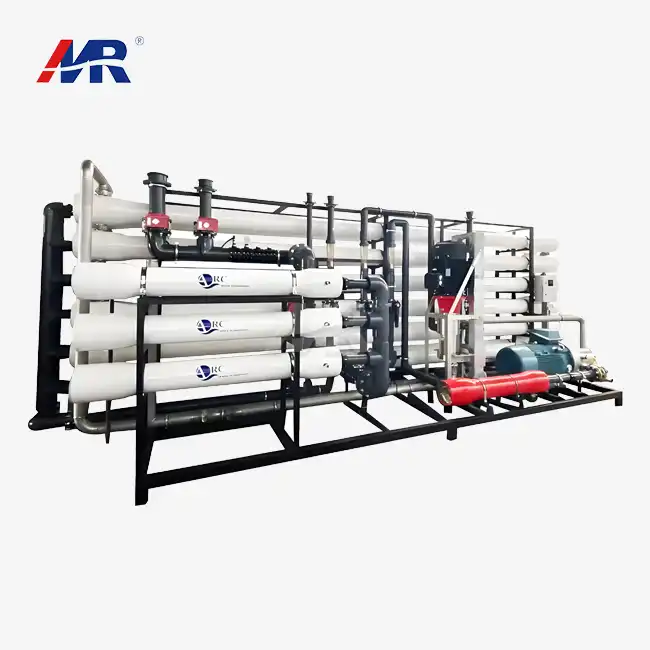Sand Filters & UF Membranes: Pre-treatment Essentials
Sand filters and ultrafiltration (UF) membranes are indispensable components in the pre-treatment phase of seawater desalination systems. These technologies work in tandem to remove a wide range of particulates and microorganisms from seawater, preparing it for the subsequent reverse osmosis process.
The Role of Sand Filters in Seawater Pre-treatment
Sand filters serve as the initial line of defense in seawater pre-treatment. These robust systems utilize layers of variously sized sand and gravel to trap suspended solids, algae, and other larger particles. As seawater percolates through the sand bed, impurities adhere to the sand grains or become trapped in the interstitial spaces. This process, known as depth filtration, is highly effective at removing particles larger than 20-30 microns.
The efficacy of sand filters in seawater desalination pre-treatment stems from their ability to handle high turbidity levels and their resistance to biofouling. Moreover, sand filters are relatively low-maintenance and can be easily backwashed to remove accumulated debris, ensuring consistent performance over extended periods.
Ultrafiltration Membranes: Fine-tuning Seawater Quality
Following sand filtration, ultrafiltration membranes further refine the seawater quality. UF membranes typically have pore sizes ranging from 0.01 to 0.1 microns, allowing them to remove fine suspended solids, bacteria, and even some viruses. This level of filtration is crucial for protecting the downstream reverse osmosis membranes from fouling and scaling.
UF membranes operate on the principle of size exclusion, where water and dissolved salts pass through the membrane while larger molecules and particles are retained. This process not only improves water clarity but also significantly reduces the silt density index (SDI), a key parameter in assessing the fouling potential of feed water in RO systems.
The integration of UF membranes in seawater pre-treatment has revolutionized the desalination industry by enhancing system reliability, reducing chemical consumption, and improving overall water quality. Their ability to consistently produce high-quality filtrate regardless of fluctuations in feed water quality makes them an invaluable asset in modern SWRO plants.
Why Is Chlorination Needed Before SWRO Processing?
Chlorination is a critical step in the pre-treatment process for seawater reverse osmosis (SWRO) systems. This chemical treatment serves multiple purposes, all of which contribute to the overall efficiency and longevity of the desalination plant.
Biofouling Prevention
The primary reason for chlorination in SWRO pre-treatment is to prevent biofouling. Seawater naturally contains a diverse array of microorganisms, including bacteria, algae, and other marine life. When these organisms accumulate on surfaces within the desalination system, they form biofilms that can severely impair equipment performance.
Chlorine, typically in the form of sodium hypochlorite, acts as a powerful biocide. It effectively eliminates or inactivates a wide range of microorganisms, preventing them from colonizing the pre-treatment equipment and, more importantly, the sensitive RO membranes. This prophylactic measure significantly reduces the risk of biofouling, which can lead to decreased water production, increased energy consumption, and premature membrane replacement.
Oxidation of Organic Matter
Another crucial function of chlorination is the oxidation of organic matter present in seawater. Dissolved organic compounds can contribute to fouling and serve as nutrients for microbial growth. Chlorine's strong oxidizing properties break down these organic substances, making them easier to remove in subsequent filtration stages.
This oxidation process not only improves the efficiency of downstream treatment steps but also helps maintain consistent water quality throughout the desalination process. By reducing the organic load, chlorination indirectly contributes to lower chemical consumption in later stages and helps preserve the integrity of the RO membranes.
Operational Considerations
While chlorination is essential for SWRO pre-treatment, it's important to note that chlorine itself can damage RO membranes. Therefore, a dechlorination step, typically using sodium bisulfite, is necessary before the seawater reaches the RO system. This careful balance of chlorination and dechlorination highlights the complexity of managing a seawater desalination plant and the importance of precise chemical dosing and monitoring.
Moreover, the chlorination process must be carefully controlled to avoid the formation of disinfection by-products (DBPs) that can be harmful to human health. Advanced monitoring systems and proper dosing strategies are employed to ensure that chlorination effectively serves its purpose without compromising the safety of the produced water.
How to Remove Algae & Organics from Seawater Intake?
Removing algae and organic matter from seawater intake is a critical challenge in maintaining the efficiency and reliability of seawater desalination systems. These contaminants can cause significant fouling issues if not adequately addressed in the pre-treatment phase. Several strategies and technologies are employed to tackle this problem effectively.
Advanced Intake Screening
The first line of defense against algae and larger organic matter is the implementation of advanced intake screening systems. These may include:
- Traveling band screens: These continuously moving screens capture and remove larger debris and marine organisms from the intake water.
- Drum screens: Rotating cylindrical screens that provide efficient removal of suspended solids and algae.
- Wedge wire screens: Fine-mesh screens that can exclude particles as small as 0.5 mm, effectively preventing the ingress of algae and organic matter.
Dissolved Air Flotation (DAF)
Dissolved Air Flotation is a highly effective method for removing algae and organic matter from seawater. In this process, air is dissolved under pressure in a portion of the clarified water, which is then recycled to the flotation tank. The released air forms tiny bubbles that attach to suspended particles, causing them to float to the surface where they can be easily skimmed off.
DAF is particularly effective for removing algae, which often have a density close to that of water and may not settle easily in conventional sedimentation tanks. The process can remove up to 99.9% of algae and significantly reduce organic content, making it an invaluable pre-treatment step in many SWRO plants.
Oxidation and Filtration
A combination of oxidation and filtration processes can be highly effective in removing algae and organics:
- Ozonation: Ozone is a powerful oxidant that can break down organic compounds and inactivate algae. It's particularly useful for treating water with high algal content.
- Advanced oxidation processes (AOPs): These utilize combinations of oxidants, UV light, and catalysts to destroy organic contaminants and algal cells.
- Multimedia filtration: Layers of different media (such as anthracite, sand, and garnet) can effectively trap algae and organic particles of various sizes.
Membrane Pre-treatment
Ultrafiltration (UF) or microfiltration (MF) membranes serve as an excellent barrier against algae and organic matter. These membranes can remove particles down to 0.01 microns, effectively eliminating algae, bacteria, and a significant portion of dissolved organic compounds. The integration of membrane pre-treatment has become increasingly common in modern seawater desalination plants due to its ability to produce consistently high-quality feed water for RO systems, regardless of variations in seawater quality.
By employing a combination of these technologies, seawater desalination plants can effectively manage algae and organic matter in their intake water. This comprehensive approach not only improves the overall efficiency of the desalination process but also extends the lifespan of critical components, particularly the RO membranes, resulting in more sustainable and cost-effective operations.
Conclusion
Pre-treatment equipment plays a vital role in ensuring the efficiency and longevity of seawater desalination systems. From sand filters and UF membranes to chlorination processes and advanced algae removal techniques, each component contributes to producing high-quality feed water for reverse osmosis. As the global demand for freshwater continues to rise, particularly in water-scarce regions, the importance of robust and effective pre-treatment in seawater desalination cannot be overstated.
Are you looking to optimize your seawater desalination process or upgrade your existing pre-treatment equipment? Guangdong Morui Environmental Technology Co., Ltd. is here to help. As a leading provider of water treatment solutions, we offer cutting-edge technologies tailored to meet the diverse needs of industries ranging from municipal utilities to offshore platforms. Our expertise in industrial wastewater treatment, domestic sewage processing, and drinking water manufacturing ensures that we can deliver a comprehensive solution for your seawater desalination needs.
With our state-of-the-art membrane production facility and partnerships with renowned brands, we're uniquely positioned to offer you the most efficient and cost-effective pre-treatment systems for your SWRO plant. Our team of experienced engineers is ready to assist you in designing a customized solution that maximizes your plant's performance while minimizing operational costs.
Don't let suboptimal pre-treatment hold back your seawater desalination plant project. Contact us today at benson@guangdongmorui.com to learn how we can help you achieve superior water quality and system reliability. Let Guangdong Morui be your partner in turning seawater into a sustainable freshwater resource for your community or industry.
References
1. Voutchkov, N. (2018). Pretreatment for Reverse Osmosis Desalination. Elsevier Science.
2. Jamaly, S., Darwish, N. N., Ahmed, I., & Hasan, S. W. (2014). A short review on reverse osmosis pretreatment technologies. Desalination, 354, 30-38.
3. Sutzkover-Gutman, I., & Hasson, D. (2010). Feed water pretreatment for desalination plants. Desalination, 264(3), 289-296.
4. Shahid, M. K., & Choi, Y. G. (2018). The comparative study for scale inhibition on surface of RO membranes in wastewater reclamation: CO2 purging versus three different antiscalants. Journal of Membrane Science, 546, 61-69.
5. Edzwald, J. K., & Haarhoff, J. (2011). Seawater pretreatment for reverse osmosis: Chemistry, contaminants, and coagulation. Water Research, 45(17), 5428-5440.
6. Prihasto, N., Liu, Q. F., & Kim, S. H. (2009). Pre-treatment strategies for seawater desalination by reverse osmosis system. Desalination, 249(1), 308-316.

_1745823981883.webp)


